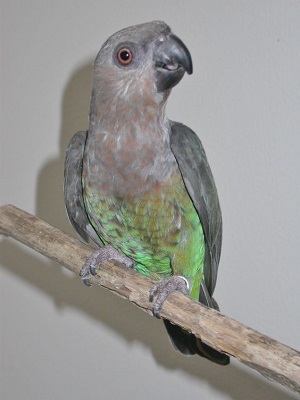
Our Animal of the Month is flying out of the spotlight today now that September is almost over. We hope you enjoyed spending time with us on “X” (formerly known as Twitter) as we posted (tweeted) fun and fascinating facts about red-bellied parrots. If you missed any of our posts (tweets) about these social and intelligent birds, here is a summary that you can reference any time. Did you know?:
- Red-bellied parrots (Poicephalus rufiventris) are native to east Africa and in the wild can be found in parts of Somalia, Ethiopia, Kenya and Tanzania.
- The red-bellied parrot is also commonly known as the African orange-bellied parrot.
- In the wild, red-bellied parrots can generally be found in dry savanna and shrubland habitats.
- More specifically, red-bellied parrots prefer habitats such as the Acacia–Commiphora bushlands and thickets ecoregion. They avoid living in dense vegetation.
- In cases where their range overlaps with their relative, the Meyer’s parrot (Poicephalus meyeri), the red-bellied parrot will choose open savanna.
- Red-bellied parrots are a medium-sized parrot, with adults typically measuring between 22 – 25 cms in length (8.6 – 9.8 inches).
- Given that the first part of their scientific name (genus) is Poicephalus, it stands to reason that red-bellied parrots have grey heads. In Ancient Greek, poi (πολιός) = grey and cephalus (Κέφαλος) = head.
- Red-bellied parrots also have dark grey beaks and deep red or reddish-brown irises.
- But if you look at a female of the species, you may wonder why she is called a red-bellied parrot at all because her red belly is nowhere to be found.
- Female red-bellied parrots actually have green feathers and tinges of orange on their bellies. The males are the ones with the bright orangey-red bellies. This difference in appearance is called sexual dimorphism.
- Both male and female red-bellied parrots have green feathers on their thighs, grey feet and blue rumps.
- In the wild, red-bellied parrots mostly eat seeds (fruit and grass), fruit and flowers. The seeds in their droppings encourage new vegetation to grow.
- They will eat insects, but insects are generally believed to be a much smaller portion of the wild red-bellied parrot diet.
- But in a 2018 article in the African Journal of Ecology, biologist Samuel E.I. Jones writes of a wild juvenile red-bellied parrot observed (and photographed) in Ethiopia feasting on a large spiny caterpillar.
- This red-bellied parrot can be seen skillfully holding up the caterpillar with one foot while ripping off chunks of the caterpillar’s body.
- Jones notes that it’s unknown if large insects actually make up a bigger portion of the wild red-bellied parrot diet than what’s currently believed and suggests more study on this is needed.
- Red-bellied parrots reach sexual maturity between one-two years of age, but they don’t usually start actively breeding until they reach the ages of three-four years.
- In the wild, red-bellied parrots will nest in tree cavities. Baobab trees are usually their tree of choice.
- Female red-bellied parrots will typically lay three eggs in a clutch. She will incubate the eggs for about a month before they hatch. The chicks will leave the nest after about two months.
- Red-bellied parrots are social birds and in the wild will live together either in pairs or in small family groups of up to four individuals.
- Sometimes red-bellied parrots will set up loose colonies in which several pairs may nest in the same tree, albeit with some distance separating each pair.
- Red-bellied parrots are considered to be “resident” birds, meaning they don’t migrate away from their breeding grounds seasonally.
- Even though red-bellied parrots aren’t migratory, the Cornell Lab of Ornithology suggests there is some local movement in northwestern Somalia as they are not normally seen in that area during the summer.
- But red-bellied parrots aren’t believed to be moving out of northwestern Somalia in the summer months, but rather up!
- The Cornell Lab of Ornithology suggests red-bellied parrots may be heading to higher elevations in northwestern Somalia between July and September in order to forage for figs.
- Red-bellied parrots are sassy, smart, social, playful and charming. Captive-bred well-socialized birds can make a wonderful addition to a family.
- While they are not well-known for their talking abilities, red-bellied parrots have some limited capability of mimicking human speech.
- With good care, red-bellied parrots have an average lifespan of about 20 years. But they can potentially live up to 30 years in captivity.

